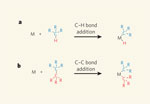Carbon–hydrogen (C–H) and carbon–carbon (C–C) bonds are the two fundamental linkages of organic molecules. They are also among those least amenable to manipulation by synthetic chemists. The discovery in the 1980s that certain transition-metal complexes can break C–H bonds through formation of the corresponding metal–carbon and metal–hydrogen bonds1, 2, 3, 4, 5 (a process sometimes referred to as C–H bond addition; Fig. 1a) was, therefore, a breakthrough. This reaction opened the way to the development of catalytic methods for the controlled modification of molecules at the site of a C–H bond. Today, C–H bond addition is one of the most dynamic areas of growth in synthetic organic chemistry6, 7, 8.
Figure 1: Bond addition reactions.
a, In C–H bond additions, a carbon–hydrogen bond in an organic molecule is broken by a metal-containing complex (M). The resulting fragments of the molecule become bound to the metal. b, The analogous reaction for carbon–carbon bonds, a C–C bond addition, is much rarer because these bonds are usually less reactive than C–H bonds. R represents any hydrocarbon group.
High resolution image and legend (18K)
By contrast, C–C bonds have proved much more resistant to cleavage by metal complexes. The relatively few known examples of C–C bond addition (Fig. 1b) typically require 'assistance', in which other groups on the organic molecule hold a C–C bond near a metal atom, or involve C–C bonds that are anomalously weak9, 10. But on page 523 of this issue, Sattler and Parkin11 report a remarkable example of C–C bond breaking in which there is no such assistance by other groups and in which the bond that is cleaved is substantially stronger than typical C–C bonds.
Sattler and Parkin performed this operation on an aromatic (benzene-like) molecule called quinoxaline (Fig. 2, overleaf). Because the C–C bond in question is part of an aromatic system, it is even stronger than a normal C–C bond. But, in contrast to benzene's all-carbon ring, quinoxaline's ring system contains two nitrogen atoms. Similar nitrogen-containing aromatic molecules are ubiquitous in biology — for example, the bases found in nucleic acids. Not coincidentally, such compounds are also commonly found in fossil-fuel sources, where they can cause problems — they deactivate the catalysts used in refining petroleum, and their combustion leads to the emission of polluting nitrogen oxides. Typically, therefore, the nitrogen must be removed by a difficult process known as hydrodenitrogenation.
Figure 2: Proposed mechanism of a C–C bond addition.
Sattler and Parkin11 report a reaction in which a tungsten complex (M) inserts into a C–C bond of quinoxaline, and suggest the following mechanism. a, The tungsten complex inserts into a C–H bond next to one of quinoxaline's nitrogen atoms, a C–H bond addition reaction. b, A second C–H bond addition takes place at the adjacent C–H bond, a reaction known as a β-hydrogen elimination. c, The two hydrogen atoms that came from the C–H bonds are lost as a molecule of hydrogen. d, Finally, the C–C bond bridged by the tungsten complex breaks, yielding the observed product.
High resolution image and legend (25K)
Parkin and colleagues previously reported12 a molybdenum complex that reacts with quinoxaline to form a simple molybdenum–quinoxaline complex — an interesting reaction, but one in which none of the quinoxaline bonds are broken. Lying immediately below molybdenum in the periodic table is tungsten. The team knew that tungsten typically behaves similarly to molybdenum, but that it is often much more aggressive with respect to breaking bonds. Even so, when Sattler and Parkin11 mixed quinoxaline with a tungsten complex analogous to the molybdenum complex used in their previous work, the results were unanticipated. They found that the tungsten atom inserted into the C–C bond located between the two nitrogen atoms in quinoxaline. In other words, the nitrogen-containing ring of quinoxaline, which consists of six atoms, had expanded to an unprecedented tungsten-containing ring system that contained seven atoms (Fig. 2).
The mechanism of this remarkable process has yet to be determined, but the authors do have enough evidence to suggest an intriguing reaction pathway. The first key step in the proposed route is insertion of tungsten into the C–H bond of one of the two carbon atoms that eventually undergo C–C addition (Fig. 2a). Next, the tungsten atom inserts itself into the C–H bond of the second carbon atom, in a reaction known as β-hydrogen elimination (Fig. 2b). The resulting metal complex then loses the two hydrogen atoms that were initially attached to the carbon atoms, generating a molecule of hydrogen (Fig. 2c). The geometry of the intermediate formed during this process puts the molecule under considerable strain, which is relieved when the system undergoes the final step to form the tungsten-containing seven-membered ring (Fig. 2d). Most importantly, the final product contains two tungsten–carbon–nitrogen–carbon linkages, known as metal-isocyanide groups. These groups are thermodynamically quite stable, and their formation undoubtedly provides much of the force that drives this unusual C–C addition process. Overall, the authors' proposed mechanism suggests that a C–H addition at a relatively inert C–H bond initiates a chain of events leading to the cleavage of an even more unreactive C–C bond.
Sattler and Parkin's reaction11 is a molecular tour de force, although it is probably a long way from seeing any useful applications. One might imagine a reaction of this type being exploited as an initial step in a tungsten-catalysed transformation; however, once formed, the metal-isocyanide groups are unreactive, which will make it difficult to incorporate them into a catalytic cycle. Nevertheless, the potential implications of the new reaction11 are great. The unusual mechanism may inspire new routes to a more general cleavage of C–C bonds, applications of which can be envisaged ranging from the syntheses of pharmaceutical compounds to the development of new catalysts for the hydrodenitrogenation of fossil fuels.
